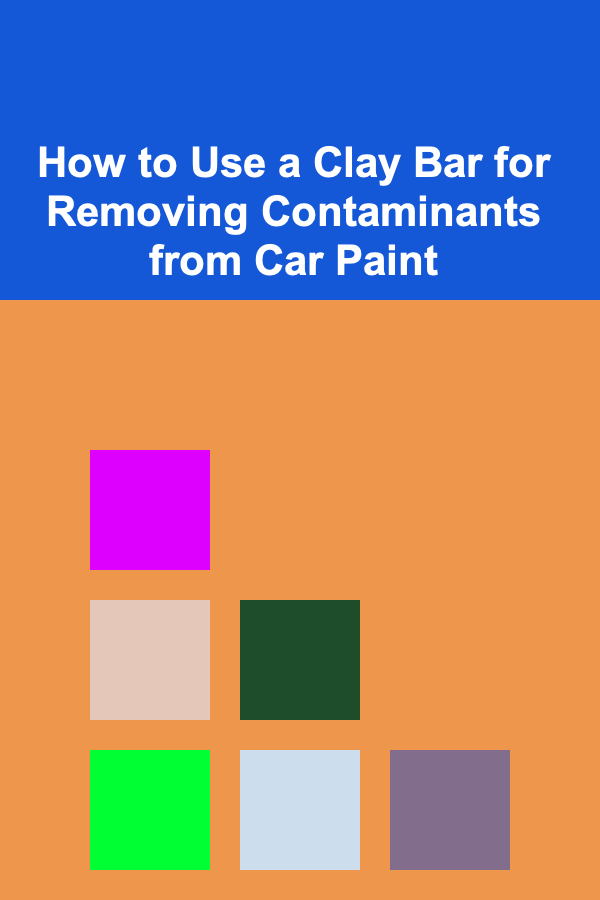
How to Use a Clay Bar for Removing Contaminants from Car Paint
ebook include PDF & Audio bundle (Micro Guide)
$12.99$5.99
Limited Time Offer! Order within the next:

Achieving a flawless, mirror-like finish on your car's paint requires more than just washing and waxing. Over time, microscopic contaminants like industrial fallout, brake dust, tree sap, and road grime become embedded in the paint's clear coat. These contaminants can't be removed with regular washing and leave the surface feeling rough and looking dull. That's where a clay bar comes in. A clay bar is an essential detailing tool designed to safely and effectively remove these embedded contaminants, leaving your paint smooth and ready for polishing and waxing.
Understanding the Need for Clay Bar Treatment
Before diving into the how-to, let's understand why clay barring is so important. Think of your car's paint as having tiny pores. These pores trap contaminants that bond to the surface. Ignoring these contaminants leads to several problems:
- Reduced Gloss and Shine: Embedded contaminants refract light, making your paint look dull and lifeless.
- Premature Paint Degradation: Corrosive contaminants can etch into the clear coat, leading to oxidation and fading.
- Wax and Sealant Ineffectiveness: Wax and sealant can't properly bond to a contaminated surface, reducing their lifespan and protective abilities.
- Swirl Mark Amplification: Rubbing contaminants across the paint surface during washing can cause fine scratches and swirl marks.
A clay bar literally pulls these contaminants out of the paint's pores, restoring a smooth, clean surface that enhances the appearance and longevity of your car's finish.
Types of Clay Bars
Clay bars come in various grades, each designed for different levels of contamination and paint sensitivity. Understanding the different types is crucial for choosing the right one for your vehicle.
- Mild Clay Bars: These are the gentlest and safest option for regular use, ideal for lightly contaminated paint or well-maintained vehicles. They are less likely to cause marring (fine scratches) but may require more passes to remove stubborn contaminants.
- Medium Clay Bars: A good all-around choice for moderately contaminated paint. They offer a balance between cleaning power and safety. Most new vehicles will benefit from using a medium grade clay bar.
- Aggressive Clay Bars: These are the most abrasive and are reserved for heavily contaminated paint or paint that has been neglected. They are more likely to cause marring and should only be used by experienced detailers or on vehicles that will be subsequently polished. Using these without proper precautions and following up with a polishing step is highly discouraged.
- Synthetic Clay Alternatives (Clay Mitts, Clay Towels): These are reusable options that offer a larger surface area and can be faster to use than traditional clay bars. However, they may not be as effective at removing deeply embedded contaminants and can be more prone to causing marring if not used carefully. They also require more meticulous rinsing.
When in doubt, start with a mild clay bar and assess the results. You can always move to a more aggressive grade if needed.
Essential Supplies for Clay Bar Treatment
Before you start, gather all the necessary supplies:
- Clay Bar: Choose the appropriate grade based on your paint's condition.
- Clay Lubricant (Detail Spray): This is crucial for preventing the clay bar from sticking to the paint and causing scratches. Use a dedicated clay lubricant or a quality detail spray designed for this purpose. Avoid using water or soap as a lubricant, as they may not provide sufficient lubrication and can damage the clay bar.
- Microfiber Towels: You'll need several clean, soft microfiber towels for wiping away the lubricant and inspecting the paint.
- Two Buckets and Grit Guards: For washing your car beforehand.
- Car Wash Soap: A pH-neutral car wash soap.
- Inspection Light (Optional): A good inspection light can help you identify areas with heavy contamination and assess your progress.
- Gloves (Optional): To protect your hands from the lubricant and contaminants.
Step-by-Step Guide to Using a Clay Bar
Follow these steps carefully to achieve the best results and avoid damaging your paint.
Step 1: Thoroughly Wash Your Car
This is the most crucial step. Clay barring should only be performed on a clean surface. Use the two-bucket method to wash your car thoroughly, removing all loose dirt and grime. Pay special attention to areas prone to contamination, such as the lower panels, wheels, and behind the wheel wells.
Why the Two-Bucket Method?
The two-bucket method involves using one bucket with soapy water for washing and another bucket with clean water for rinsing your wash mitt. This prevents you from transferring dirt and grime back onto your car's paint, minimizing the risk of scratches.
- Fill one bucket with car wash soap and water according to the manufacturer's instructions.
- Fill the other bucket with clean water.
- Place grit guards in both buckets.
- Dip your wash mitt into the soapy water and wash a section of your car.
- Rinse the wash mitt in the clean water bucket, removing any dirt and grime.
- Repeat steps 4 and 5 for each section of your car, ensuring the wash mitt is always clean.
Step 2: Dry Your Car Completely
Use a clean, soft microfiber towel or a dedicated car dryer to thoroughly dry your car. Any remaining water can interfere with the clay bar's performance.
Step 3: Prepare the Clay Bar
Take the clay bar out of its packaging. Knead it in your hands until it becomes soft and pliable. This helps to activate the clay and ensures it conforms to the contours of your car's surface. Flatten the clay bar into a pancake shape for easier handling.
Step 4: Lubricate the Surface
This is the most important step for preventing scratches. Liberally spray the area you're working on with clay lubricant. The surface should be wet and slippery. Work in small sections, approximately 2ft x 2ft.
Step 5: Glide the Clay Bar
Gently glide the clay bar back and forth across the lubricated surface, using light to medium pressure. Avoid pressing down too hard, as this can cause the clay bar to stick or mar the paint. Listen for a change in the sound as the clay bar removes contaminants. The surface should become smoother and less gritty as you work.
Overlap each pass slightly to ensure complete coverage. Maintain a smooth, consistent motion and avoid stopping the clay bar mid-stroke.
Step 6: Inspect and Refold the Clay Bar
After working a section, inspect the clay bar. You'll likely see embedded contaminants on the surface. Fold the clay bar over to reveal a clean surface. Knead the clay bar again to redistribute the contaminants. This provides a fresh surface for continued cleaning. If the clay bar becomes heavily contaminated, discard it and use a fresh piece.
Step 7: Wipe Away the Lubricant
Once you've finished claying a section, use a clean microfiber towel to wipe away any remaining lubricant. Inspect the surface for any residual contaminants or marring.
Step 8: Repeat the Process
Repeat steps 4 through 7 for each section of your car's paint, including the hood, roof, doors, and trunk. Pay extra attention to areas that are prone to contamination, such as the lower panels and behind the wheels.
Step 9: Final Inspection and Wash (Optional)
Once you've clayed the entire car, give it a final inspection. If you notice any areas that you missed, repeat the claying process. You may want to wash your car again to remove any residual lubricant or clay residue, although this is usually not necessary if you use a generous amount of lubricant and wipe it away thoroughly.
Step 10: Polish (Recommended)
Clay barring, especially with medium or aggressive clay, can sometimes leave behind very fine marring in the paint. While often not visible to the naked eye, polishing will remove this marring and restore the paint's clarity and gloss. This is a highly recommended step, particularly if you used a more aggressive clay bar.
Step 11: Protect Your Paint
After clay barring and polishing, it's essential to protect your paint with a wax, sealant, or ceramic coating. This will help to prevent future contamination and maintain the smoothness and shine of your paint.
Tips and Tricks for Clay Bar Success
Here are some additional tips to help you get the best results from your clay bar treatment:
- Work in a Shaded Area: Direct sunlight can cause the lubricant to dry too quickly, making the clay bar stick to the paint.
- Keep the Surface and Clay Bar Well Lubricated: Don't be stingy with the lubricant. It's better to use too much than not enough.
- Don't Drop the Clay Bar: If you drop the clay bar on the ground, discard it immediately. It can pick up dirt and debris that will scratch your paint.
- Use a Light Touch: Let the clay bar do the work. Avoid pressing down too hard.
- Replace the Clay Bar Regularly: Over time, the clay bar will become saturated with contaminants and less effective. Replace it when it becomes heavily soiled or difficult to clean.
- Store the Clay Bar Properly: Store the clay bar in its original packaging or in an airtight container to prevent it from drying out.
- Consider the Temperature: Clay bars work best at moderate temperatures. Avoid using them in extreme heat or cold. If it's too hot, the lubricant will evaporate quickly. If it's too cold, the clay bar may be too stiff.
- Test on an Inconspicuous Area: Before claying the entire car, test the clay bar on a small, inconspicuous area to ensure it doesn't cause any damage.
- Listen to the Paint: As you clay, listen to the sound. A rough, gritty sound indicates contamination. As the contaminants are removed, the sound will become smoother and quieter.
Troubleshooting Common Clay Bar Problems
Even with careful technique, you might encounter some problems. Here's how to troubleshoot them:
- Clay Bar Sticking to the Paint: This usually means you're not using enough lubricant or the surface is too dry. Add more lubricant and re-clay the area.
- Marring or Swirl Marks: This can be caused by using an aggressive clay bar, not using enough lubricant, or pressing down too hard. Polish the affected area to remove the marring.
- Clay Bar Tearing or Crumbling: This can be caused by using an old or dried-out clay bar, or by exposing the clay bar to harsh chemicals. Replace the clay bar.
- Difficulty Removing Contaminants: This may indicate that you're using a clay bar that is too mild for the level of contamination. Try using a more aggressive clay bar.
Conclusion
Using a clay bar is a relatively simple but incredibly effective way to restore the smoothness and shine of your car's paint. By following these steps and tips, you can safely and effectively remove embedded contaminants, leaving your car looking its best. Remember to choose the right clay bar for your paint's condition, use plenty of lubricant, and work in a shaded area. With a little practice, you'll be able to achieve professional-level results and enjoy a flawlessly smooth, glossy finish.

How to Balance a Full-Time Job with Part-Time Typing Work
Read More
How to Effectively Use the Invitation Homes Maintenance Line for Quick Repairs
Read More
How to Get Rid of Dust in Every Corner of Your Home
Read More
How to Organize Your Home Security Records
Read More
How to Use Robo-Advisors for Hands-Off Investment Management
Read MoreHow to Build a Fixed Expenses Tracker in Google Sheets
Read MoreOther Products

How to Balance a Full-Time Job with Part-Time Typing Work
Read More
How to Effectively Use the Invitation Homes Maintenance Line for Quick Repairs
Read More
How to Get Rid of Dust in Every Corner of Your Home
Read More
How to Organize Your Home Security Records
Read More